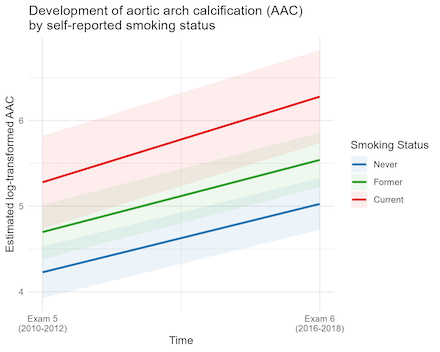Final ID: P1159
Aortic Arch Calcification Improves Cardiovascular Event Risk Stratification Among Individuals With a History of Cigarette Smoke Exposure
Abstract Body: Cigarette smoking and aortic arch calcification (AAC) are powerful risk factors for incident cardiovascular disease (CVD), but their relationship is yet to be thoroughly investigated. We used data from the Multi-Ethnic Study of Atherosclerosis to examine the development and progression of AAC, and the extent to which AAC can risk stratify for CVD, among individuals with a history of smoking.
Our study sample consisted of 2846 men and women in the US aged 53 to 93 years old who were scored for AAC at two exams roughly 5 years apart. We hypothesized that cigarette smoke exposure would be significantly associated with AAC at initial exam, with AAC progression between exams, and that AAC would improve risk prediction accuracy for CVD among smokers. We used linear mixed-effects models to assess AAC development and progression, proportional hazards models to investigate the relationship between AAC and incident CVD among smokers, and the area under the time-dependent receiver-operator characteristic curve (AUC) to characterize model prediction accuracy. All models were adjusted for demographic and cardiovascular risk factors.
Relative to participants who never smoked, being a former or current smoker was significantly associated with higher AAC at initial exam (P=0.001), but not AAC progression between exams. Among current or former smokers, a one-unit increase of log-transformed AAC was associated with a 20.6% increased risk of CVD (P<0.001), and a 13.0% increased risk of all-cause mortality (P=0.01). The inclusion of AAC as a risk factor among smokers improved the 8-year AUC for CVD events from 0.731 to 0.778. In conclusion, AAC is a measure of atherosclerotic burden that can improve risk stratification for CVD in smokers.
Our study sample consisted of 2846 men and women in the US aged 53 to 93 years old who were scored for AAC at two exams roughly 5 years apart. We hypothesized that cigarette smoke exposure would be significantly associated with AAC at initial exam, with AAC progression between exams, and that AAC would improve risk prediction accuracy for CVD among smokers. We used linear mixed-effects models to assess AAC development and progression, proportional hazards models to investigate the relationship between AAC and incident CVD among smokers, and the area under the time-dependent receiver-operator characteristic curve (AUC) to characterize model prediction accuracy. All models were adjusted for demographic and cardiovascular risk factors.
Relative to participants who never smoked, being a former or current smoker was significantly associated with higher AAC at initial exam (P=0.001), but not AAC progression between exams. Among current or former smokers, a one-unit increase of log-transformed AAC was associated with a 20.6% increased risk of CVD (P<0.001), and a 13.0% increased risk of all-cause mortality (P=0.01). The inclusion of AAC as a risk factor among smokers improved the 8-year AUC for CVD events from 0.731 to 0.778. In conclusion, AAC is a measure of atherosclerotic burden that can improve risk stratification for CVD in smokers.
More abstracts on this topic:
Analysis of Polarization Changes in Ascending Aortic Endothelial Cells Induced by Aortic Valve Regurgitation
Tamagawa Yuki, Miyagawa Shigeru, Kawamura Takuji, Harada Akima, Miyake Keisuke, Kawamura Ai, Kido Takashi, Yamashita Kizuku, Shimamura Kazuo, Saito Shunsuke
Assessing low-density lipoprotein cholesterol (LDL-C) equations in childhood for long-term risk of cardiovascular disease events: Superior performance of the Sampson equationMeng Yaxing, Steinberger Julia, Urbina Elaine, Venn Alison, Viikari Jorma, Whitaker Kara, Woo Jessica, Raitakari Olli, Magnussen Costan, Wu Feitong, Juonala Markus, Jacobs David, Bazzano Lydia, Daniels Stephen, Dwyer Terence, Kahonen Mika, Sinaiko Alan

